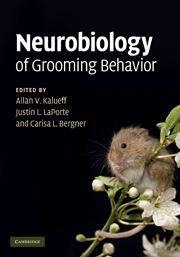Book contents
- Frontmatter
- Contents
- List of contributors
- Preface
- 1 Grooming, sequencing, and beyond: how it all began
- 2 Self-grooming as a form of olfactory communication in meadow voles and prairie voles (Microtus spp.)
- 3 Phenotyping and genetics of rodent grooming and barbering: utility for experimental neuroscience research
- 4 Social play, social grooming, and the regulation of social relationships
- 5 Grooming syntax as a sensitive measure of the effects of subchronic PCP treatment in rats
- 6 Modulatory effects of estrogens on grooming and related behaviors
- 7 Lack of barbering behavior in the phospholipase Cβ1 mutant mouse: a model animal for schizophrenia
- 8 Grooming after cerebellar, basal ganglia, and neocortical lesions
- 9 Striatal implementation of action sequences and more: grooming chains, inhibitory gating, and the relative reward effect
- 10 An ethological analysis of barbering behavior
- 11 Should there be a category: “grooming disorders?”
- 12 Neurobiology of trichotillomania
- Index
Preface
Published online by Cambridge University Press: 04 August 2010
- Frontmatter
- Contents
- List of contributors
- Preface
- 1 Grooming, sequencing, and beyond: how it all began
- 2 Self-grooming as a form of olfactory communication in meadow voles and prairie voles (Microtus spp.)
- 3 Phenotyping and genetics of rodent grooming and barbering: utility for experimental neuroscience research
- 4 Social play, social grooming, and the regulation of social relationships
- 5 Grooming syntax as a sensitive measure of the effects of subchronic PCP treatment in rats
- 6 Modulatory effects of estrogens on grooming and related behaviors
- 7 Lack of barbering behavior in the phospholipase Cβ1 mutant mouse: a model animal for schizophrenia
- 8 Grooming after cerebellar, basal ganglia, and neocortical lesions
- 9 Striatal implementation of action sequences and more: grooming chains, inhibitory gating, and the relative reward effect
- 10 An ethological analysis of barbering behavior
- 11 Should there be a category: “grooming disorders?”
- 12 Neurobiology of trichotillomania
- Index
Summary
Grooming and related behaviors
Behavioral and pharmacological research continues to play a crucial role in modern neuroscience, often spearheading new and innovative techniques and models that further our understanding of the intricate workings of the nervous system. This is particularly evident in the arena of mental health research where, with the help of animal models and novel genetic or pharmacological treatments, new insights and theories are evolving to conceptualize more accurately common brain disorders such as anxiety, depression, obsessive–compulsive disorder (OCD), and schizophrenia.
These advances are allowing for an unprecedented examination of the heritable and environmental factors that contribute to disease pathogenesis. However, although there has been marked progress, the biological substrates of many of these disorders remain unclear. To establish a more concrete understanding of these disorders, a careful dissection of experimental phenotypes must be pursued. In this way, every aspect of behavior is a potentially fruitful source of experimental data that can provide clues to the contributing mechanisms.
One important example of such a behavior is grooming. Grooming is a very highly represented behavior in many animals, comprising a large proportion of their waking time. It serves an incredibly diverse range of purposes in the life of the animal from chemocommunication to basic hygiene. It is a natural behavior, yet it can be induced as part of an experimental procedure and has been shown to be sensitive to stress and bidirectionally sensitive to anxiolytic and anxiogenic drugs in rodents, making it an ideal focal point for high-throughput behavioral studies.
- Type
- Chapter
- Information
- Neurobiology of Grooming Behavior , pp. xi - xviPublisher: Cambridge University PressPrint publication year: 2010



